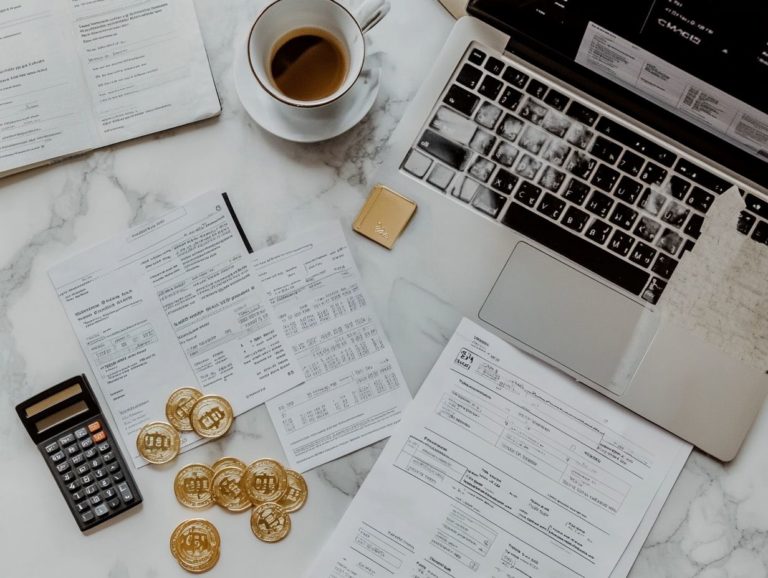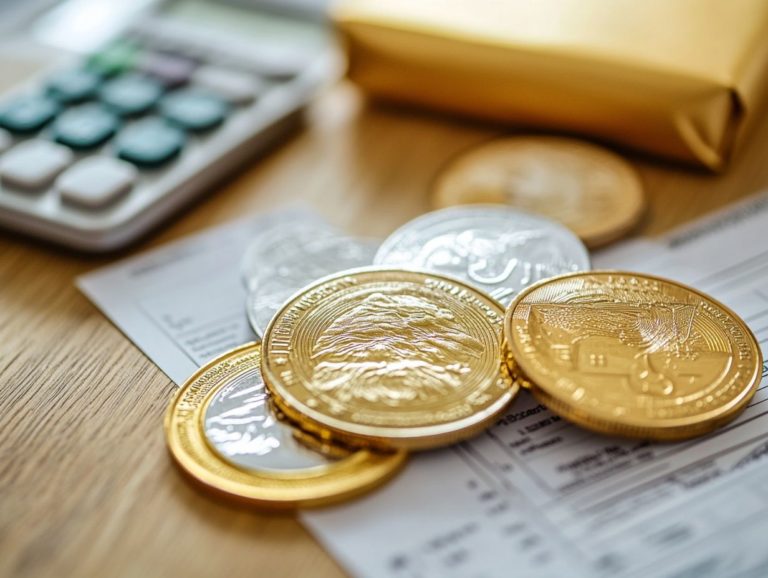The Importance of Tax Planning for Precious Metals Investors
Investing in precious metals can be a rewarding venture. However, navigating the intricate landscape of tax laws and regulations is essential for maximizing your returns.
This article explores tax planning tailored for precious metals investors. You ll learn about the tax implications and how to use tax-advantaged accounts. We will share effective strategies to minimize losses and help you avoid common pitfalls.
We ll also highlight the benefits of working with a tax professional to improve your investment strategy.
Keep reading for insights that could profoundly influence your investment journey!
Contents
- Key Takeaways:
- Mastering Tax Planning for Precious Metals: The Essentials
- Benefits of Tax Planning for Precious Metals Investors
- Maximizing Returns and Minimizing Losses
- Strategies for Tax Planning in Precious Metals Investments
- Common Mistakes to Avoid in Tax Planning for Precious Metals
- Working with a Professional for Tax Planning in Precious Metals
- Frequently Asked Questions
- What is tax planning for precious metals investors?
- Why is tax planning important for precious metals investors?
- What are some tax strategies for precious metals investors?
- What are the potential tax implications for precious metals investors?
- How can tax planning impact long-term investment goals for precious metals investors?
- Are there any risks associated with tax planning for precious metals investors?
Key Takeaways:

- Proper tax planning helps you earn more and lose less.
- Strategies like diversification, timing, and using tax-advantaged accounts can be beneficial.
- Working with a tax professional helps avoid mistakes and ensures compliance with tax laws.
Mastering Tax Planning for Precious Metals: The Essentials
Tax planning for precious metals investors is crucial in navigating tax laws and regulations. Given the unique tax implications tied to investments in metals like gold, silver, and platinum, it’s vital to understand concepts like tax on profits from selling investments, reporting requirements, and your financial obligations.
Understanding these tax rules will not only boost your returns but also keep you on good terms with the IRS. Consulting with a tax professional can provide you with valuable insights into effective investment strategies and estate planning.
This proactive approach will help you manage your tax liabilities while building a robust investment portfolio.
Understanding Tax Laws and Regulations
Grasping tax laws and regulations is essential as a precious metals investor. It allows you to navigate the complexities of tax on profits from selling investments and the reporting requirements set by the IRS.
These laws specify how your gains from selling gold, silver, platinum, and other metals are classified whether as collectibles or investments. This classification directly impacts the tax rates you’ll face. It’s vital for you to understand the differences between long-term and short-term capital gains, as how long you own an asset significantly affects your tax burden. Additionally, you should be aware of the tax responsibilities of precious metals investors to ensure compliance.
Short-term gains from assets held for one year or less are taxed at ordinary income rates, whereas long-term gains typically benefit from lower capital gains rates. This intricate framework underscores the importance of consulting a seasoned tax professional who can provide personalized advice for compliance and effective tax planning tailored to your investment strategies.
Benefits of Tax Planning for Precious Metals Investors
Tax planning offers a wealth of advantages for precious metals investors like you. It helps you optimize your returns, minimize potential losses, and discover available tax deductions that can significantly reduce your tax liabilities over time.
By using strategic tax-loss harvesting techniques a strategy to sell losing investments to reduce your taxable income you can effectively navigate economic downturns and inflation. This ensures that your investment portfolio remains resilient while fully compliant with tax regulations.
Maximizing Returns and Minimizing Losses

Maximizing your returns while minimizing losses is essential as a precious metals investor. You have a range of investment strategies at your disposal to navigate the complexities of the effects of taxes on profits effectively.
By employing techniques like dollar-cost averaging and diversifying across various metal types, you can create a strong investment portfolio that stands the test of time! Take advantage of tax-advantaged accounts to build resilience. Knowing the importance of tax compliance for precious metals investors can also help you navigate the complexities of timing your asset sales, which can significantly influence your capital gains tax liabilities. With effective tax planning, you can pinpoint opportunities to harvest losses that offset gains elsewhere, leading to a more favorable financial outcome overall.
Stay ahead of the game by keeping an eye on market trends and expert insights; it s crucial for maximizing your gains. This can give you a strategic advantage, enabling you to take calculated risks that enhance profitability while protecting against potential downturns.
Strategies for Tax Planning in Precious Metals Investments
Implementing effective tax planning strategies for your precious metals investments is crucial for ensuring compliance while maximizing your potential returns.
By focusing on diversification and timing strategies that align with market trends, you can navigate this complex landscape with confidence and finesse.
Diversification and Timing Strategies
Diversification and timing strategies are essential for you as a precious metals investor, especially if your goal is to protect your assets and effectively capitalize on market trends.
By allocating your resources across various asset classes think stocks, bonds, and commodities you can create a safety net that cushions against potential losses in any single investment. This method not only balances your overall portfolio but also enhances your tax outcomes by strategically leveraging the different tax treatments associated with various investments.
Understanding market cycles can significantly influence when you decide to purchase precious metals. During economic downturns, these assets often serve as safe havens. Seizing such opportunities allows you to optimize your returns while safeguarding your wealth against inflation and currency fluctuations.
Using Tax-Advantaged Accounts
Utilizing tax-advantaged accounts such as IRAs, Roth IRAs, and 401(k)s can provide you with significant advantages as a precious metals investor, enhancing your asset protection and opening doors to potential tax deductions.
These accounts present a unique opportunity for you to diversify your portfolio while enjoying the prospect of compounded growth over the long term. By rolling over existing retirement funds into a self-directed IRA (a retirement account you manage yourself), you can allocate a portion of your investments specifically toward precious metals like gold and silver, which are often viewed as safeguards against inflation and market volatility. Additionally, understanding the role of precious metals in a tax-efficient portfolio can further enhance your investment strategy.
You may also find that contributions to these accounts are tax-deductible, depending on your personal income levels, which further bolsters your investment returns. It s crucial to remain vigilant about IRS Form 5498 for reporting contributions and Form 1099-R for distributions to ensure compliance with tax regulations.
By adhering to these specific reporting obligations, you can maximize the benefits of your accounts without inadvertently encountering tax penalties.
Common Mistakes to Avoid in Tax Planning for Precious Metals

Avoiding common mistakes in tax planning for your precious metals investments is crucial for protecting yourself against tax evasion, penalties, and non-compliance with reporting obligations.
Failing to navigate these complexities can lead to serious financial repercussions that you certainly want to steer clear of.
Start planning your investments today to secure a prosperous future!
Pitfalls and How to Avoid Them
Recognizing and addressing the pitfalls in tax planning is essential for you as a precious metals investor. Avoiding tax evasion is critical for your success! It s important to steer clear of the penalties laid out by the IRS.
Failing to file accurate IRS forms can invite unnecessary audits and hefty fines. Therefore, it s vital to fully grasp your filing obligations. If you miscalculate capital gains tax, you risk underreporting your income a mistake that can have serious consequences. To navigate these complexities, adopting a disciplined approach to maintaining comprehensive and precise records is imperative.
You should:
- Document each transaction meticulously,
- Track the purchase and sale dates,
- Maintain receipts for all relevant expenses.
By doing so, you ensure that you re well-prepared to provide accurate reports in the event of an IRS inquiry.
Working with a Professional for Tax Planning in Precious Metals
Engaging a tax professional is an essential advantage for precious metals investors. This guarantees that you follow tax laws while developing effective investment strategies that align seamlessly with IRS regulations and reporting requirements.
The Role of a Tax Advisor or Accountant
A tax advisor or accountant is crucial for you as a precious metals investor. They guide you through the intricacies of tax planning, ensuring your compliance with tax laws while recommending investment strategies designed to optimize returns and minimize liabilities.
It’s important that these professionals deeply understand both the nuances of tax legislation and the unique dynamics of the precious metals market. Their expertise enables them to assess your current investment positions and market trends, helping you make well-informed decisions regarding the tax impact of precious metals in your financial strategy.
By providing tailored advice that harmonizes your immediate financial objectives with long-term wealth preservation, they assist you in navigating the complexities of capital gains taxes (taxes on profits from selling investments), reporting requirements, and potential legislative changes, including understanding collectibles tax on gold and silver. Ultimately, their guidance is vital in crafting a comprehensive investment strategy that aligns perfectly with your individual risk tolerance and financial aspirations.
Frequently Asked Questions

What is tax planning for precious metals investors?
Tax planning for precious metals investors involves strategizing and managing investments in precious metals to minimize tax implications and maximize profits.
Why is tax planning important for precious metals investors?
Tax planning is important because it can help reduce the amount of taxes paid on profits, potentially increasing overall returns.
What are some tax strategies for precious metals investors?
Some strategies include holding investments in tax-advantaged accounts, such as a Roth IRA, and utilizing tax-loss harvesting to offset gains.
What are the potential tax implications for precious metals investors?
Potential tax implications may include capital gains taxes, income taxes, and estate taxes, depending on the type of investment and the investor’s tax situation.
How can tax planning impact long-term investment goals for precious metals investors?
By implementing effective tax planning strategies, investors can potentially increase their long-term profits and reach their investment goals faster.
Are there any risks associated with tax planning for precious metals investors?
As with any investment strategy, there are risks involved. It’s important to consult with a financial advisor and carefully consider the potential risks before implementing any tax planning strategies.
Ready to take charge of your tax planning? Consult a tax advisor today to optimize your investments and secure your financial future!













